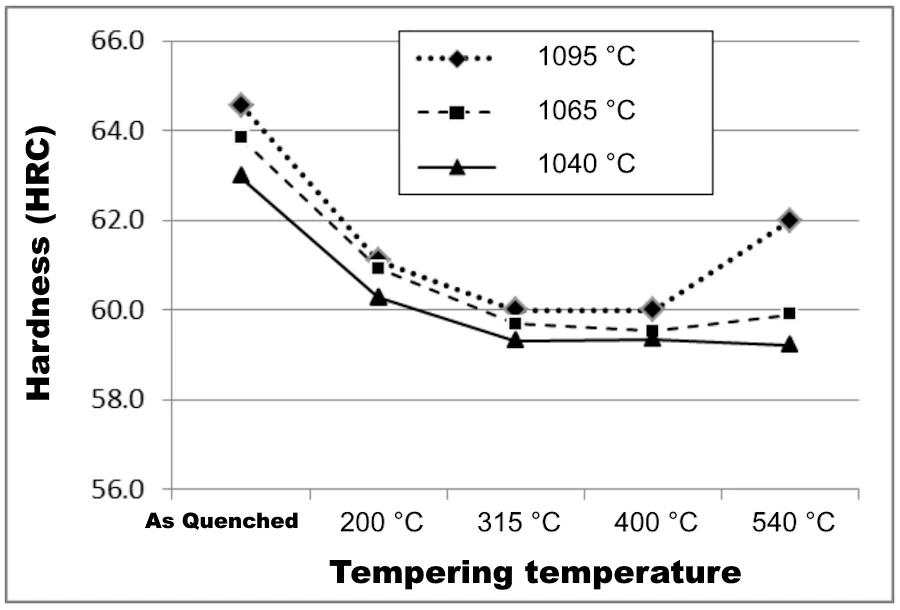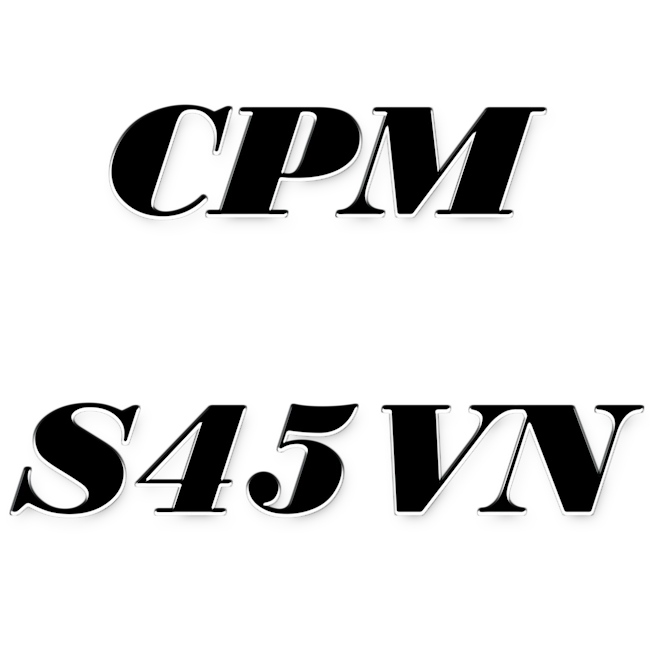CPM S45VN is a martensitic stainless steel designed to provide improved corrosion and wear resistance over CPM S35VN. Its chemical composition has been rebalanced so that it forms more chromium carbides while leaving more free chromium in the matrix. The use of niobium and nitrogen in place of some of the vanadium and carbon provides an excellent combination of edge retention, wear resistance, corrosion resistance and toughness, making it an ideal choice for knife steel.
The CPM process produces highly homogeneous, high quality steel characterized by superior dimensional stability, grindability and toughness compared to steels produced by traditional melting methods.
S45VN is a relatively new stainless steel powder knife steel made in the USA. It was first introduced in November 2019 by Crucible Industries in collaboration with Niagara Specialty Metals. CPM S45VN has very good corrosion resistance and edge retention at a hardness of 61 - 62 HRC, as well as good impact toughness.
Typical applications
- Special durable cutlery;
- Plastic injection and extrusion feed screws and dies;
- Check valve components;
- Pelletizing equipment;
- Wear-resistant components for food and chemical processing.
Note: These are some typical applications. Your specific application should not be undertaken without independent study and evaluation for suitability.
Chemical composition
Chemical composition of steel grade CPM S45VN | ||||||
| C | Cr | Mo | V | Nb | N | Fe |
| 1,48 | 16,0 | 2,0 | 3,0 | 0,5 | 0,15 | Other |
Physical properties
- Modulus of elasticity: 221 GPa;
- Density: 7.47 g/cm3;
- Thermal conductivity at 93 °C: 17.31 W/m-°K;
- Coefficient of thermal expansion::
20 - 200 °C: 11.0X10-6 mm/mm/°C;
20 - 315 °C: 11.5X10-6 mm/mm/°C;
Mechanical properties
Although the longitudinal toughness of all four of these grades is about 25-28 ft. lbs., the transverse toughness of the CPM grades is four or more times that of 440C and 154CM. The higher transverse toughness results indicate that CPM S45VN, CPM S35VN and CPM S30V are much more resistant to chipping and breaking in applications which may encounter side loading. In knifemaking, the higher transverse toughness makes CPM especially good for bigger blades.
Edge retention
| Grade | % |
| CPM S45VN | 143* |
| CPM S35VN | 140* |
| CPM S30V | 145 |
| 154CM | 120 |
| 440C | 100 |
The CATRA (Cutlery & Allied Trades Research Association) test machine performs a standard cutting operation and measures the number of silica impregnated cards which are cut. It is considered a measure of relative wear resistance, reported in this table as compared to a 440C standard.
*Estimate based upon market feedback
Thermal treatments
- Forging: 1150 °C. Do not forge below 950 °C.
- Annealing: Heat to 900 °C, hold 2 hours, slow cool no faster than 15 °C per hour to 595 °C, then furnace cool or cool in still air to room temperature.
Annealed Hardness: about BHN 255
Stress relieving
- Annealed parts: heat to 595 - 705 °C, hold for 2 hours, cool in an oven or in air.
- Hardened parts: heat to 15 - 30 °C below the original tempering temperature, hold for 2 hours, then cool in an oven or in air.
- Straightening: best done warm 200 - 425 °C.
Hardening
- Preheat: heat to 845 - 870 °C. Equalize.
- Austenitization: 1035 - 1095 °C, holding time at temperature 15-30 minutes.
- Quench: air or positive pressure quench (2 bar minimum) to below 50 °C, or salt or interrupted oil quench to about 540 °C, then air cool to below 50 °C.
- Temper: double temper at 200 - 400 °C. Hold for 2 hours minimum each time. A freezing treatment may be used between the first and second tempers. Freezing treatments help to attain maximum hardenability and must always be followed by at least one temper.
NOTE: For optimum stress relieving, CPM S45VN may be tempered at 540 - 550 °C. Tempering in this range may result in a slight decrease in corrosion resistance. - Size change: +0.05 to +0.10% when fully martensitic. The presence of retained austenite may reduce the net growth. When tempering at 200 - 400 °C, freezing treatments may be necessary to minimize retained austenite.
Recommended heat treatment:
Austenitize 1065 °C. Quench to below 50 °C. Double temper at 315 °C 2 hrs. minimum each temper. Cool to hand warm between tempers. A freezing treatment may be added between tempers.
Aim hardness: 59-61 HRC.
Note: properties shown throughout this data sheet are typical values. Normal variations in chemistry, size and heat treat conditions may cause deviations from these values.
Heat treatment response - hardness (HRC) CPM S45VN | ||||||
| Austenitizing temperature | ||||||
| 1040 °C | 1065 °C | 1095 °C | ||||
| Tempering temperature | Oil | Oil + Freeze Liquid N2 | Oil | Oil + Freeze Liquid N2 | Oil | Oil + Freeze Liquid N2 |
| As Quenched | 62,6 | 63 | 63,5 | 63,8 | 63,3 | 64,6 |
| 200 °C | 60,2 | 60,3 | 61,1 | 60,9 | 60,6 | 61,1 |
| 315 °C | 59,3 | 59,3 | 59,5 | 59,7 | 58,5 | 60,0 |
| 400 °C | 59,7 | 59,3 | 59,6 | 59,5 | 58,7 | 60 |
| 540 °C | 59,2 | 59,2 | 60 | 59,9 | 61,5 | 62 |
| Results may vary with hardening method and section size. Salt or oil quenching will give maximum response. Vacuum or atmosphere cooling may result in up to 1-2 HRC points lower. | ||||||
| Minimum Time at Aust. Temp. | 30 min. | 30 min. | 15 min. | |||
| Minimum Number of Tempers | 2 | 2 | 2 | |||

Machinability and Grindability
In the annealed condition, CPM S45VN is much easier to machine than CPM S90V and easier to machine than CPM S30V. Similar grinding equipment and practices used for high speed steels are recommended. “SG” type alumina wheels or CBN wheels have generally given the best performance with CPM steels.
CPM S45VN steel is a martensitic stainless steel with increased resistance to corrosion and wear compared to previous grades of similar composition.
